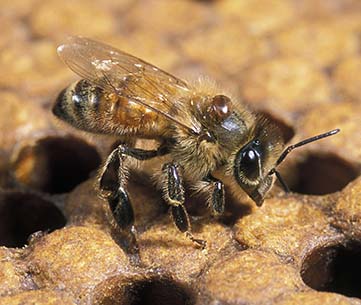This week was January 19, 2023, the day Marty McFly arrived in the movie Back to the Future. The movie was released in 1985, and did so well that it became a trilogy that included trips to the future and the past. In Marty’s 2023 they had real hover boards and self-fitting clothes and other things that seemed futuristic back in the 1980’s.
It occurred to me that that’s about when the varroa mite invaded the United States as well, long before I took up beekeeping. The mite first appeared in Florida and then quickly spread to the rest of the country. With a scientific name of Varroa destructor, Varroa is an ectoparasitic mite that lives and feeds on the adult and pupal stages of honey bees. They have proven surprising resilient and very adaptive to the various treatment methods tried over the years.
For many years Australia was the only country in the world free from Varroa mite. The pest appeared there in 2022, and bees in the country are still on lock down as authorities work to eradicate the mite. Hopefully they will be successful, only time will tell. The mite is especially devastating to honey bees and beekeepers not used to dealing with it.
The image here, from the site beeaware.org.au, shows the relative size of a mite compared to a bee. For a human, it would be like having a large Frisbee attached to your shoulder that you just couldn’t shake off. It cannot be very pleasant.
In the United States, where commercial honey bees are big business, various chemical treatments have been used over the years to deal with the pest. While these work to some extent, they have allowed the mite to develop some resistance to these chemicals, and our commercial beekeepers to keep use bees that are highly susceptible to the mite. It is not a good situation.
In countries like South Africa and Brazil that have a much poorer beekeeping community, some resistance to the pest has evolved over the past two decades and honey bees in these countries appear to be less susceptible to the pest.
It seems quite the shame that in Marty McFly’s future the varroa mite is still such a destructive pest to honey bee colonies in the United Status.
May you prosper and find honey.

Erik, what do you do to control the mites with your bees? What do the sustainable beekeeping communities in the US do?
LikeLike
There are synthetic and natural chemicals. Most commercial beekeepers use the synthetic amitraz as it is easy and safe in most weather. More sustainable beekeepers like myself use chemical treatments derived from formic acid, oxallic acid, or thymol. These appear naturally in nature so bees have a natural resistance, and they kill the mites effectively. These natural chemicals are considered safe on organic farms as well, though there are temperature and efficacy guidelines that you have to follow.
Some beekeepers go “treatment free” which means different things to different people. Under USDA standards, it is considered cruel to let an animal get sick and die when a treatment is possible, even for organic and sustainable farming. So I’m not a big fan of the approach, as in most areas of the country an untreated hive will whither and die over time.
LikeLike